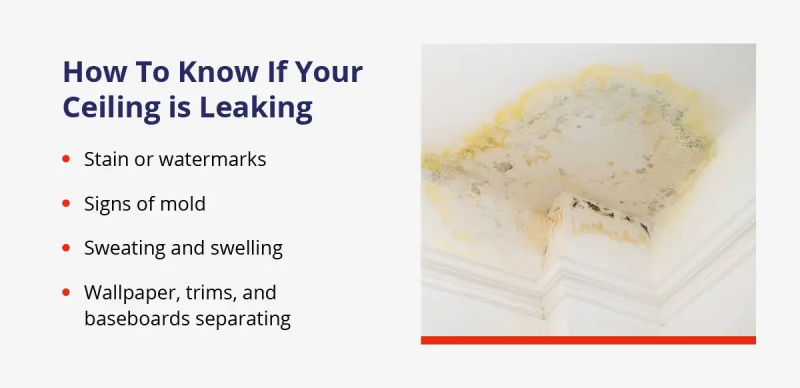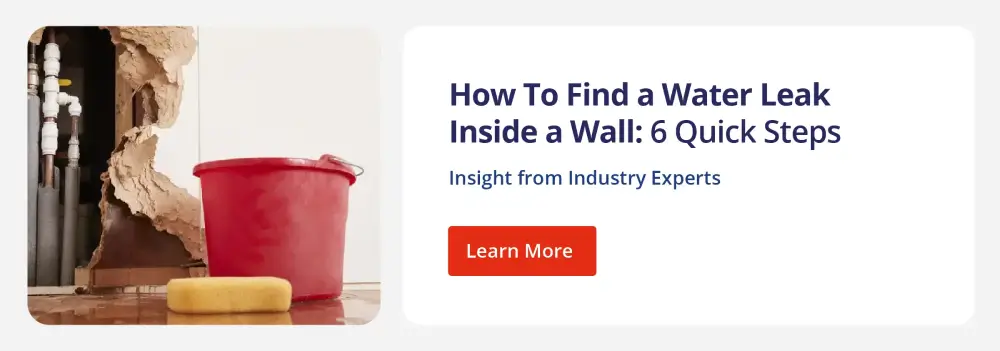
If you notice water leaking through your ceiling, prompt action is crucial to prevent further damage. Rainbow Restoration recommends:
|
Originally Published August 4, 2020
When water is leaking from the ceiling, immediate action is required to prevent further damage. Act fast by shutting off the water supply, catch or soak up excess water, and contact a water damage restoration company to remediate the ceiling water damage.
When ceiling leaks occur, they should be immediately addressed. If droplets come through the ceiling or even damp, soft water spots appear on the surface, it's important to take immediate action.
When left untreated, water damage in a ceiling can lead to mold and structural damage, making the space unsafe to occupy. Call a plumber and professional restoration company like Rainbow Restoration® to restore the space to its best possible condition.
Learn the common signs of ceiling water damage, how to stop the issue from getting worse, and when to work with water damage restoration professionals to mitigate and remediate ceiling leaks.
Table of Contents:
- What to Do if Water Leaks From the Ceiling
- 4 Signs of a Ceiling Leaking
- Why Does Water Leak Through Ceilings?
- When To Call a Professional
- Who Do I Call for a Water Leak in the Ceiling?
- FAQ About Water Leaking from Ceilings
What To Do if Water Leaks From the Ceiling
The longer a leak continues, the greater the risk of extensive water damage. If there’s an active water leak or water damage has occurred, take these steps immediately to mitigate the damage.
- Turn off the water supply: The recommended first step for stopping a leak is to shut off its source. To do so, close the main water shut-off valve. Turning off the water supply should stop the leak until a professional arrives. However, if the leak is weather-related, shutting off the main valve won’t have any effect.
- Move furniture out of the way: To save personal belongings, it’s best to move them or cover them with a tarp to prevent extensive water damage. This includes furniture, electronics, curtains, and rugs.
- Catch the water to avoid further damage: Place buckets or large containers underneath the ceiling leak to catch any dripping water.
- Call a water damage professional: Ceiling leaks can be messy and lead to more than just water damage. A professional will make qualified recommendations to restore or mitigate water damage. They’ll also check for the presence of mold and take the necessary steps.
4 Signs of a Leaking Ceiling
In most cases, the signs of water damage from a ceiling leak are obvious. Water stains or water dripping from the ceiling to a puddle on the floor or sagging ceiling tiles are clear indicators. But what if the signs are more subtle?

Below are some common signs of ceiling water damage. If any of the following signs appear, it’s crucial to stop the water leak right away to prevent further water damage.
Stains or watermarks
Watermarks may appear in rust or brown tones and in ring shapes around light fixtures. Stains located at the top of a wall where it meets the ceiling and that appear to drip down may also hint that the leak originated in the ceiling.
Signs of mold
Where there’s a neglected water leak and/or a high moisture problem, there’s mold. It only takes about 48 hours of wetness for mold fungus to grow.
Understanding the different appearances of mold can help in identification. Mold may look like the following:
- White, green, black, gray, yellow, light orange, or pink in color.
- Slimy, fuzzy, powdery, or wool-like in texture.
People and pets may experience symptoms of mold exposure, like allergy and asthma flare-ups or unresolved, lingering coughs.
Sweating and swelling
A leak can cause water damage in floors, ceilings, doors, walls, and windows. It often leads to sweating or swelling from the high moisture content. In this case, look for:
- Beading water droplets on ceilings and walls
- Doors not closing properly due to swelling
- Bubbling paint
Wallpaper, trim, and baseboards separating
When excess moisture causes walls and ceilings to swell, decorative features may also be affected. Wallpaper, baseboards, and trim may separate and buckle away from the surface they’re adhered to.

Why Does Water Leak Through Ceilings?
Water leaks through ceilings for multiple reasons. Understanding the why can be a quick process when dealing with a bigger, obvious issue like a busted pipe in winter or requires experience in finding where the slow leak sits that has been causing water damage in the ceiling over time. A professional attic and roof inspection may be necessary to find why there is a leak. Some common reasons for water leaking through ceilings include issues with pipes, air conditioners, water heaters, bathroom fixtures, gutters, and roofs.
Damaged pipes
Damaged pipes are one of the most common sources of ceiling leaks.
- Pipes rust and wear as they age, which may cause cracks and holes.
- Cold weather may cause pipes to freeze and then burst.
- Clogged pipes may cause pressure to build up, forcing pipes to crack.
- Pipes may be damaged from renovations.
Leaking shower or bathtub
If a bathroom is directly above where the ceiling is leaking or the bathroom floor is flooded, there’s the culprit. Pipes, sinks, toilets, and bathtubs can all experience water leaks. For example, sources of shower and bathtub leaks include:
- Cracks
- Drain leaks
- Overflow
- Worn seals
Overflowing gutter
Ceiling leaks that occur on outer walls where the gutter meets the house may be due to clogged or damaged gutters. Overflowing rain gutters full of leaves, sticks, and rainwater can do more than damage a building's exterior — when left unaddressed for an extended period of time, clogged gutters can cause moisture to seep through the walls into the interior of your property.
Damaged Roof
Another common source of ceiling leaks is roof damage. Roof leaks may occur after storms, causing a leaky ceiling from rain. Tree debris and normal age-related wear can also lead to roof damage and a leaking ceiling.
Keep in mind roof repair is a complex, specialized task best left to the professionals. In order to stop water from leaking through the ceiling immediately, consider using a professional residential tarp-over service to mitigate water damage until a professional roofer can address the problem.
When To Call a Professional
Even minor water leaking from the ceiling can lead to extensive water damage and mold. The best course of action after the leak is identified is to contact a professional water damage remediation expert.
Who Do I Call for a Water Leak in the Ceiling?
A local Rainbow Restoration team of IICRC-certified service professionals has the knowledge and tools to restore any home or business, mitigating and remediating damage from a ceiling leak.
Since mold grows quickly and different types of water damage that can be difficult to spot and fix without experience, call Rainbow Restoration for professionalism you can trust.
Rainbow Restoration’s water damage restoration process includes:
- Finding the source of the leak
- Rapid structural drying to halt moisture progression
- Restoring the area, which may include mold removal, odor removal, tarping, and more, depending on the situation and the local Rainbow Restoration
This article is intended for general informational purposes only and may not be applicable to every situation. You are responsible for determining the proper course of action for your home and property. Rainbow Restoration is not responsible for any damages that occur as a result of this blog content or your actions. For the most accurate guidance, contact the Rainbow Restoration location nearest you for a comprehensive, on-site assessment.
FAQ About Water Leaking from Ceilings
Setting the highest standards in water, fire, and mold damage restoration requires a continuous focus and dedication to education and improvement. Rainbow Restoration service professionals are graded and evaluated on response time, professionalism, and customer satisfaction. This commitment to exceptional service also includes using our years of experience and expertise to answer your restoration-related questions.
Here are answers to some of the most frequently asked questions about a water leak in the ceiling.
Should I call a plumber or the water utility company if my ceiling leaks?
Call an emergency plumber if there’s water leaking through the ceiling. The water utility company is only contacted if the leak is located before the main shut-off valve.
Do plumbers fix ceiling leaks?
A plumber can find the source of a leak and stop it. However, they don’t fix the resulting water damage. Call a restoration professional to properly dry the area and fix any water damage.
Does homeowners insurance cover water leaks in a ceiling?
Homeowners insurance will typically cover restoration after a ceiling leak as long as the cause is a covered peril. Some situations, such as leaks from a flood or resulting from the homeowner’s negligence, might not be covered. Consult your policy to determine if a water leak is covered.
Is a ceiling leak an emergency?
Yes, water leaking from the ceiling is an emergency that requires immediate action. Delaying repair will worsen the extent of the water damage and potentially lead to mold growth.
How long does it take for a ceiling to dry out after a leak?
Drying out a ceiling leak can take anywhere from a couple of days to a few weeks, depending on the severity and the extent of the water damage and your weather conditions. Professionals with proper ventilation tools, fans, and dehumidifiers can speed up the drying process.
Can a ceiling collapse from a water leak?
Yes, it’s possible for a ceiling to collapse from a water leak if not repaired quickly. A gallon of water weighs nearly 8.5 pounds, so it doesn’t take much water accumulation to overwhelm the structural integrity of the ceiling.
How do I find out where my ceiling is leaking from?
A professional attic and roof inspection may be necessary to find where a leak is coming from.
